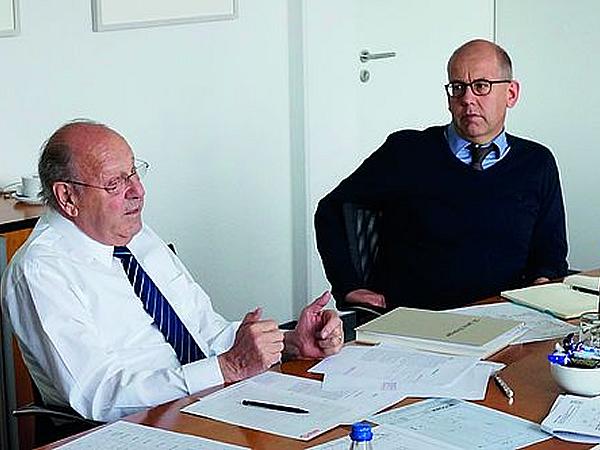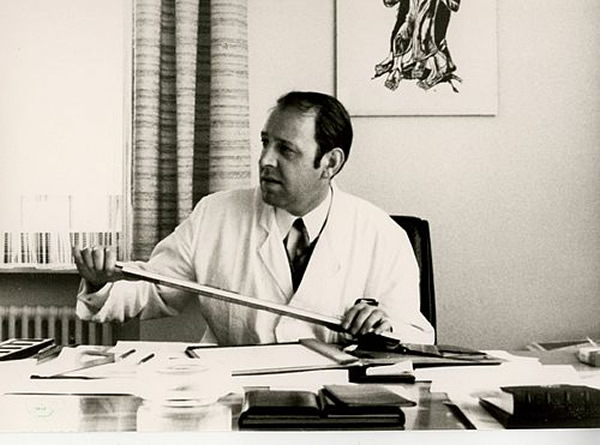
Façades, windows and doors in metal are popular due to their extreme stability, weather resistance and durability. However, aluminium and steel are known to have a high thermal conduction capacity.
To guarantee high-energy efficiency, good thermal separation is vital. Wilfried Ensinger, plastics expert and inventor of the world's first series-produced insulating profile, talked to us about how insulbar came into being.

Mr Ensinger, what was it that drew your attention as a young plastics engineer to the subject of energy efficiency in the construction industry?
W.E.: The enormous energy savings potential. At the beginning of the seventies – I remember this very precisely – I had a very large oil tank installed in my house. In those days, we still paid under ten cents for a litre of fuel oil.
Nevertheless, I was the first in our village to insulate my house with the innovative insulating material polystyrene. People thought it was hilarious: Ensinger is off his rocker! Then came the oil crisis. That’s when everything changed radically.
The prices for crude oil shot up in 1973 and again in 1979/80. Energy costs just kept going up. Was the world of metal window construction prepared for this?
W.E.: There was a movement towards the idea of improving thermal separation: Some used a polyurethane foam filling for the frame, some opted for long fabric strips hardened with epoxy resin, while others used short pieces of polyamide or polyester. But system manufacturers encountered major problems with the plastic solutions.
By the time the component went for anodizing or stove enamelling the elements had become deformed or no longer sat perfectly. The state-of-the-art solutions at the time were too fault-prone, complex, time-consuming and expensive.
You founded your company in 1966. Why do you think people had confidence in a solution that came from a newcomer to the industry?
W.E.: The method we used had a key role to play. It was due to this method that I took the step of starting my own business: We were the only provider capable of supplying glass fibre reinforced plastic products to the required degree of precision.
With our ready extruded semi-finished products, we achieved far narrower tolerances than would have been possible with machined plastics. And word got around. At our first trade fair in 1978, even our competitors were sending customers who had tricky problems to solve over to our stand.
What was your suggestion for window, door and façade construction?
W.E.: When the system manufacturer Wicona approached us, our engineers were in no doubt about what was required: What we needed were low thermal conduction capacity, alongside high stability, shear strength and thermal stability.
We opted to use the glass fibre reinforced polyamide 66, whose coefficient of thermal expansion precisely corresponds to that of aluminium. This allowed us to minimize the stresses occurring with changes of temperature. In addition, it was possible to coat the aluminium-plastic assembly using heat treatment at up to 200° C.
What challenges did you face from the first prototypes through to the series manufacturing stage?
W.E.: Back in the mid seventies, we planed and milled the first prototypes out of a panel. We threaded these into the guides in the aluminium profiles and they fitted just fine. But the aim was for the assembly to be permanently seated without wobbling.
It wasn't easy explaining to customers that as well as friction locking, positive locking was also required. So I filed a toothed section into the aluminium guide. The significantly better thrust this created proved a compelling argument.
So you paved the way for the rolling and knurling method in widespread use today?
W.E.: Yes, this wasn't the commonly used method beforehand. However, if the profile is simply pushed in, even the smallest tolerances can add up to significant weak spots. By knurling and rolling, these can be minimized. But we had to prove this first.
So in the presence of the ift Rosenheim and the Federal Institute for Materials Research and Testing, we extensively tested the new type of assembly, both using good, very precisely processed aluminium profiles, and others which were not so good.
Turning theory into practice: How was the insulating profile tested?
W.E.: We subjected the profiles to exhaustive mechanical and temperature testing, and examined the shear strength. The results formed the basis for standardization. Working in cooperation with BASF, we also tested the compatibility of the plastic with almost 70 different substances and processes which commonly occur in the construction of windows.
The test results were then published in trade journals. This gave us and our customers the necessary degree of certainty and enabled our entry into the marketplace.
Your first customer was then your development associate Wicona, today a premium brand of the globally active Sapa Group.
W.E. That's right, we went into series production in 1977 for Wicona. Our cooperation was and still is very close. And this type of partnership tends to open doors: The whole of the industry was keen to use our solution.
This meant that our business grew rapidly, naturally offering individually adjusted profiles. In addition to our location in Nufringen, in 1980 we opened our factory in Cham, where we have been series producing our insulating profiles under the insulbar brand ever since.
How big was Ensinger when insulbar launched, and what was the extent of the development department?
W.E.: Oh, I took care of development and tooling for many years myself – up until the introduction of the hollow chamber in 1995. I spent long hours at the drawing board, including Saturdays and Sundays. Initially, the product was further developed by our application engineers and staff from the stock shapes department.
But as the market boomed, so did the piece numbers. By as early as 1980, both divisions had reached almost equal size. When things took off with insulbar, it was almost like founding another company – and its rapid expansion meant we experienced growth pains.
Was there already an export market or were insulating bars for metal construction mainly something taken up by the German market?
W.E.: Initially it was the latter. But Switzerland was also very eco-conscious and was a target market from the start. In the German-speaking countries, expectations are often high, but so are the purchase quantities.
This gave us and the industry a good grounding in preparation for export. Soon, we had customers in Italy, Spain, France and the UK. In the USA, Turkey and China too, the importance of energy efficiency is on the rise. There is plenty of potential yet to be uncovered!
Growing markets tend to sow the seeds of competition. Were you able to maintain a unique edge and set yourself apart?
W.E.: We had competition and that's a good thing. But there was actually nobody capable of producing to such a standard of precision or surface quality. The tolerances allowed by DIN were around +/- 0.2 mm. But for this type of application, it simply isn’t enough!
We were supplying to a tolerance of +/-0.02 mm. A special technique we use means that the glass fibres are multi directionally oriented in our insulating bars, which works to ideally counter shear forces. None of our competitors were able to imitate this effect.
And what happened to the alternative materials and processes?
W.E.: Many of them were discontinued relatively quickly. Because the requirements imposed on the plastic are very high, in particular as regards thermal stability and durability. Clearly, the frames can’t be allowed to fall apart or drop down.
We were expected to produce profiles that would last at least 20 years. It brings you out in a sweat just thinking about it. But in terms of design, our products were solid and meticulously engineered. And we now know: If correctly used, insulbar has a life of at least 40 years.
As the pioneer in this field, there must have been many things you needed to develop. Could you give us a few examples of innovations which are still valid today?
W.E.: We were practically always the first. For instance, I had to have the first ever knurling wheel produced here in our tooling department, because such a thing simply didn't exist.
The CoEx wire which is co-extruded when the plastic is melted and moulded in the foot of the insulating profile is also now considered the standard. This allowed the shear strength of the plastic profile to be further improved, and it creates a moisture barrier which provides a reliable seal even under driving rain.
Since the first, simply formed insulating bar, the profiles have grown ever more complex. Why?
W.E.: Because the demands made on them are so varied. Depending on the application, certain materials, wall strengths, insulating depths or profile geometries fit better than others.
Alongside the mechanical properties, customers are sometimes concerned particularly about efficient further processing, sometimes about fire protection, sustainability or excellent thermal separation, for instance with insulbar LO or thermally reflecting foil. We take these individual requirements into account as standard.
Who drives forward the further development of profiles – Ensinger or the customer?
W.E.: Both. There are some innovations which are sparked by us. But mostly, it’s the customer who has an idea, and we find a way of implementing it.
This is where our strengths in the fields of compounding and extrusion are extremely valuable. What's decisive is that we understand the market and the processing side of things intimately. When we talk to the designers and make suggestions, we have to stay focused on how we can offer our customers an advantage.
Do you assume that demand for thermal insulation in metal windows, doors and façades will continue to grow?
W.E.: Definitely. We’ve played a part in creating the technical conditions for ever greater energy efficiency, but the real requirement is being driven by growing environmental awareness in the population.
This can be more or less pronounced from one country to the next, but is growing worldwide. Another factor is ever more stringent regulations imposed on energy efficiency, as has happened recently in countries such as Spain and Italy. This situation produces a temporary boom in the construction industry.
Do you think there will be a time when the question of energy efficiency will run out of steam?
W.E.: Not in the foreseeable future. But something I don’t welcome is being forced by energy legislation to implement improvements right down to the fifth digit after the decimal point.
The cost to value ratio has to be right. An interesting approach from the costing point of view would be to replace more metal by plastic. The benefits would increase as a result of integrating additional functions such as dazzle protection, security sensors, lighting or electrical systems for window operation.
Looking into your crystal ball: What future developments do you envisage for insulbar?
W.E.: Oh, I’ve been away from the cutting edge too long to say. You need to get to the trade fairs, go out to customers and talk to people on the ground. This is the way we’ve always operated. This is the only way to get a feel for what’s going on in the world of application engineering. We are problem solvers with high quality aspirations.
This is what we always aimed to be. We have people working here who ooze creativity and inventive spirit, who are always striving to go one step further. To be this driven, you have be open to crazy ideas and dream dreams – and that goes for technology too.
Mr Ensinger, thank you for taking the time to talk to us.
W.E.: My pleasure.


 You are not logged in, please sign in to view contact
You are not logged in, please sign in to view contact Info release
Info release Promotion
Promotion Building shop
Building shop Online business
Online business